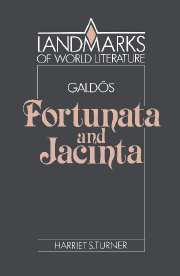Book contents
3 - Metaphors of mind
Published online by Cambridge University Press: 18 December 2009
Summary
The analogical matrix
When describing realism in the novel Galdós stresses neither fact nor fiction but likeness/comparison. His avowed aim was not to depict an object but to surround it, so to speak, by establishing dialectical patterns that build a sense of character, sketch in dot-images or formulate imagistic progressions. As the characters experience events, sometimes glossing their own story, their thoughts and words appear against a background of voices that resonate within a nexus of relations. The narrator develops these relations by passing known facts through told stories, imparting a visual and auditory sense of Galdós's equation, of things tacitly compared and maintained in balance.
This nimble touch likens the narrator at times to Juanito Santa Cruz, also adept at analogies in story-telling. What Hafter calls a kind of ironic reprise fades in and out among narrative styles, in this case exposing Juanito, the very man the narrator intends to punish. As Hafter says, internal repetitions, a variety of verbal echoes and the mirroring of one character in another reveal, “in varied pairings the novelist's irony has fashioned, more about themselves and about the surrounding reality than they themselves understand” (MH, 233). In Fortunata and Jacinta, then, as Rodgers has observed of Miau, irony and analogy become the two prongs of an instrument that catches hold of an object and renders it real in terms of the novel. Whereas the two stories of married women evolve within what is common, ordinary and everyday (vivienda), metaphor is what really catches hold of the “inner doing” (fazienda) of a character's mind, which Galdós sees as the essence of being.
- Type
- Chapter
- Information
- Galdós: Fortunata and Jacinta , pp. 92 - 118Publisher: Cambridge University PressPrint publication year: 1992
- 3
- Cited by



